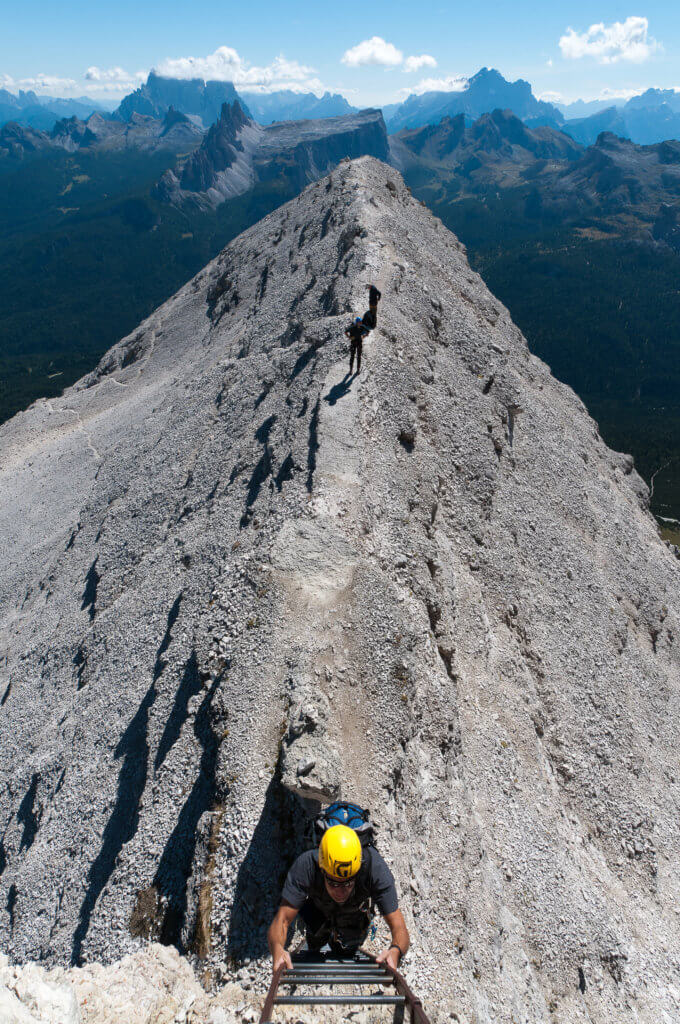Spring in Cortina, offers tourists a wide range of new opportunities: hiking, running, climbing, biking and of course via ferrata routes. A via ferrata (Italian for “iron way”) is a mountain route equipped with metal cables, ladders or steps, and other exciting features such as wooden walkways and suspended bridges. These artificial aids facilitate exposed routes and make them feasible even to hikers and unexperienced climbers, allowing them to reach the otherwise inaccessible peaks of high mountains in safe conditions, enjoy stunning views and experience a day of adventure! All you need is specific via ferrata equipment and possibly the company of a local mountain guide.

Cortina is a wide valley surrounded by a 360° array of mountains and the resort with the highest number of via ferratas in the Dolomites, with one or several on many of its most famous peaks, including Tofane, Cristallo and Faloria. There are easy ones suitable for beginners and families as well as difficult ones for the most experienced hikers and outdoor adventurers.
Via ferratas date back mainly to the First World War, when exposed routes and itineraries used by soldiers needed to be equipped with cables and ladders. However, several via ferratas were built beforehand. The first one in the Ampezzo valley, one of the first in the Dolomites, if not the very first one, was built in 1905 by the blacksmith Minighel. He forged nearly 270 pitons and fixed them on the vertical wall, creating a quicker, more direct route from the Glanvell Refuge to the Giussani Refuge. Today, the via ferrata is known as La Scala del Minighel (Minighel’s Ladder) and is still considered to be one of the must-dos of the area. Here are some via ferratas with various levels of difficulty. Be aware, none of them are for the fainted heart!
Some stunning via ferrata routes in Cortina:
Starting with an easy one, Via Ferrata Fanes Waterfalls has a vertical climb of 600 meters. This is an easy, panoramic and scenic via ferrata route, partially within gorges and steep valleys, that leads to the meeting point of the valleys of Fanes and Travenanzes – an area of great landscape and hydrogeological majesty. The sequence of potholes, rapids and waterfalls along the Rio Fanes is extraordinarily beautiful and the Lower Fanes Waterfalls are among the highest and largest in the Dolomites.

The route winds through the Natural Park of the Ampezzo Dolomites and is ideal for families and children or for those who attempt a via ferrata for the first time. It has a number of stunning views and equipped sections with metal cables in the most exposed points and is doable in either direction.
The ascent of the Rio Fanes River, is the most challenging section with a descent into the gorge, the thrilling experience of crossing the waterfall, climbing up to the summit of the opposite side with metal cables, crossing a bridge over long and spectacular rapids and finally taking a brief equipped path along a ledge behind the waterfall. Animal lovers and children will find this route particularly interesting, as it offers the chance to catch sight of the rare eagle-owl and the red and grey wallcreeper.
You can find more info on this via ferrata here.
For the more adventurous, there is Via Ferrata Strobel – Punta Fiames, Pomagagnon at a medium level of difficulty. However, a mountain guide is recommended. The vertical gain is 950 meters to an altitude of 2,250 meters (approx. 7,300 feet).

Punta Fiames, overlooking the valley of Fiames, is the western pinnacle of Pomagagnon. Well exposed to the sun, the ferrata Strobel is accessible almost all year round.
This via ferrata is one of the most classical of the area, offering an amazing view on the whole Ampezzo valley. It goes up through the west face of Punta Fiames, along ledges and chimneys and a variety of landscapes. The route, exposed in some parts but well equipped, wanders back and forth up the flank of the west wall with a series of steep protected sections among ledges, stunning rock ceilings and sections of not so steep paths covered by dwarf mountain pines, very typical of the area.
You can find more info on this via ferrata here.
Now, for the master mountain climber there is Via Ferrata Olivieri – Punta Anna, Tofana di Mezzo. This one is at a difficult level, with a vertical gain of 1,480 meters (4,800 feet) and an a altitude of 2,576 meters (8,450 feet); therefore, we recommend a mountain guide.

Punta Anna is the first buttress of the peak Tofana di Mezzo, part of the Tofane mountain range. The starting point is very close to the Hut Pomedes, ideal spot for a coffee or a drink on one of the most stunning terraces of the Dolomites.
The via ferrata is quite difficult and exposed: the ascent, almost entirely equipped with cables, follows the steep southern arête up to Punta Anna. It’s undoubtedly one of the most spectacular via ferrata routes in the Dolomites: its steep exposure and beauty make it extremely rewarding and the view on the imposing Tofana di Rozes is unforgettable. Experts and thrill-seekers can extend the ferrata by combining it with others close by, including the ascent to the summit of the Tofana di Mezzo, the highest peak in Cortina.
You can find more info on this via ferrata here.
Press release and photos courtesy of Cortina Marketing.






